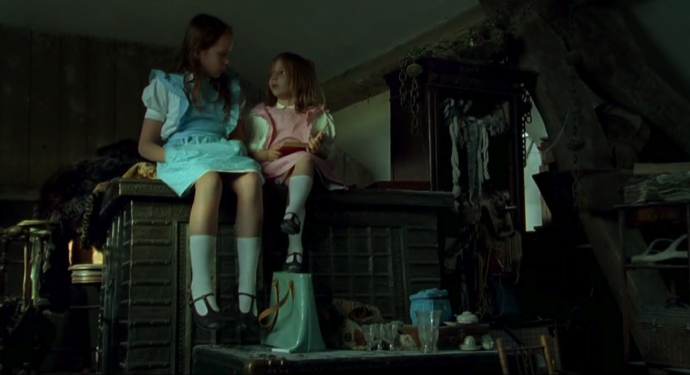Apr 24, 2010
La Barbe-Bleu [Bluebeard, Catherine Breillat, 2009] or Catherine Breillat and the École Lacanienne
I want to talk about a particular instance (perhaps a small, striking moment) in Bluebeard, Catherine Breillat’s provocative take on the classic fairytale by Charles Perrault. i As she has done in previous films (most notably Anatomy of Hell), Breillat makes use of a framing device to set off the dominant narrative, punctuating the Bluebeard story with interludes of two young sisters reading the tale aloud to each other. As Micheal Koresky writes in his excellent Reverse Shot review:
The device becomes a way for Breillat to both make a greater dramatic point—about how rules of male courtship are imbued into girls at an early age—and to simultaneously deflate her own drama by acknowledging it as child’s play. The younger girl, Catherine, played by five-and-a-half-year-old Marilou Lopes-Benites, is more curious, and in ways more sexually sophisticated than her older sister, Marie-Anne (Lola Giovannetti), even if she mixes up and misinterprets some of the information she’s gleaned from the adult world—when speaking of marriage between a man and a woman, she insists that after the wedding, “they want to become homosexuals.†Her older sister corrects her, saying, “Marriage is when two people love each other.†With a glint of sly self-confidence, little Catherine retorts, “No, homosexuality is when they’re in love.â€
This little exchange provokes a genuine burst of laughter — and Breillat in general is not known for inducing giggles. While the joke is funny on a contemporary level (petite Catherine should be enlisted as the cutest Prop. 8 activist ever) it is also a Lacanian jeu d’espirit that reveals an anxiety over heteronormative coupling (which reaches its apogee with marriage). Specifically, it reminds me of an anecdote in L’Instance du La Lettre in which a little boy and a little girl (Lacan informs us they are brother and sister) are seated across from each other in the train compartment. There is a window that affords them a view of the platform where two doors are situated. The little boy speaks first upon the train coming to a stop. “Look,†he says, “We’re at Ladies!†His sister insults him: “Imbecile!†she says, “Don’t you see we’re at Gentlemen.â€
But–attendez!–both children are equally mistaken, because they confuse the plaques above the bathroom doors that bear the signifiers “Ladies†and “Gentlemen†with their current location, the name of the train station. Lacan, ever the raconteur, can’t resist a bit of hyperbole when he ostensibly gets around to the point of this story: “To these children, Gentlemen and Ladies will henceforth be two homelands toward which each of their souls will take flight on divergent wings.” This is evidently a joke with not-so-funny moral: Heterosexual orientation (which is by no means biologically necessary) is an association that is gradually learned: it is an ideological position that is taken up through normative conditioning, through repeated re-marking.
The sisters’s dialogue in Bluebeard also emphasizes the role of signifiers as they are inducted (in part through fairytales) into the École des Femmes, and petite Catherine’s playful attitude towards words reveals a suggests an whimsical attitude towards language in which words are not tools but toys, and words can mean whatever the child wants them to mean. (Alice in Wonderland: “At least I mean what I say–that’s the same thing, you know.”) However, what is amusing and curious in children is pathological in adults; evidently, once a child reaches a certain age, he or she cannot play with the materiality of the signifier in quite the same unconscious way.
From a textual standpoint, the framing device reveals Lacanian frame of mind — something I think often gets overlooked when considering Breillat’s approach to cinema. It is the equivalent of a parallax view, providing a vantage point from which to “look awry” at the Bluebeard story. The framing device de-sutures us from the Bluebeard narrative and its accompanying circuit of male/female desire. It also provides an obstacle to identifying too closely with any one character — and that’s exactly what makes Breillat’s films so much more interesting than that particular genre of European art porn (or something like The Girlfriend Experience). Her films constantly question our perceptions of intimacy, which is precisely a question of where we end and others begin.
On that note, here is an extraordinary interview with the provocatrice herself on that very subject. Her view on art: “Everything can be expressed by 24 images per second and 26 letters.”

[…] own internal logic — and this is a genre that Breillat understands at a cellular level. (One blogger has even used the psychoanalyst scholar Lacan to explain her work.) Inasmuch as she fleshes out Marie-Catherine’s personality, she does so in a way that still holds […]